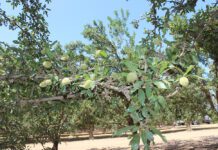Orchard soils lacking in adequate calcium levels at harvest time can lead to abiotic stress in trees and result in physiological disorders. This nutrient is critical during hot summer months due to its positive effect on root health. Root growth slows and stops when calcium is not supplied to root tips. Without adequate water uptake ability, stress, disease and insect pressure are inevitable.
Calcium
Devin Clarke, crop manager for tree nuts for Yara North America emphasized the important role of calcium in moisture management at the Almond Day event held in Fresno on June 12. This workshop gave an overview of nutrient and moisture management pre-harvest.
Calcium improves both physical and chemical aspects of soil, Clarke said. It assists in soil aggregation and water infiltration. It also prevents soil crusting due to rain or irrigation water hitting the ground. Chemically, calcium assists with cation balance and competition.
Heavier soils can present challenges with water infiltration. Clay particles are negatively charged and repel one another. Calcium binds clay particles together while sodium pushes clay particles apart.
Calcium Uptake
Calcium is in competition with other major cations in soils including sodium, potassium, magnesium and ammonium. Calcium uptake by tree roots is depressed when ratios with those cations are not optimum. Over application of ammonium nitrates also depress calcium uptake. Calcium should be 60-85 percent of CEC (cation exchange capacity), Clarke said.
Calcium uptake occurs at root tips and the zone of lateral growth. Eighty-nine percent of relative calcium uptake takes place from zero to thee inches behind the root tip. Root growth also requires a continuous supply. If soils are deficient in calcium, root growth will be stunted and root tips will die.
Young tissue exhibits calcium deficiency because calcium is immobile within plants. Deficiency can show up on leaf margins, blossom end of fruit or in center of some plants.
Another key function of calcium is the active transport of potassium across guard cell membranes of stomata. This movement induces the opening and closing of the stomata allowing cooling of the whole plant. Calcium also serves as a defense mechanism for plants. When a plant takes up calcium it will have stronger cell walls and membranes. Leaf hardening is accelerated making them less attractive to sucking insects and disease vectors. It also reduces activity of enzymes produced by fungi or bacteria, preventing penetration of plant tissues.
Solubility of calcium sources varies. Ag lime takes 7,940 gallons of water to dissolve one pound. Gypsum needs 40 gallons per pound while calcium nitrate takes 0.6 gallon. Fertigated calcium moves together with nitrate in sandy and clay soils.
Moisture Management
Certified crop advisor Rich Kreps explained the value of moisture management in tree nut crops pre-harvest.
The reality of growing almonds in California led to this advice from Kreps: “It’s going to be hot. You need to water.”
To do a better job of ensuring optimal soil moisture pre-harvest, growers should be aware of soil types across the block and check moisture levels regularly. Both deep moisture and root zone moisture are needed and anaerobic conditions for long periods are to be avoided. Matching water demand and understanding soil reports are key points in moisture management.
Balanced Plant Nutrition
When plant nutrition is balanced, Kreps said, less total nutrients are used, which saves money. If fertigation isn’t working, use foliar sprays for the limited nutrients in plant-ready form. Over application of one nutrient can block another’s efficacy. A healthy, balanced tree will have less disease and pest pressure.
Use of soluble nutrients will help draw water down, Kreps said. Shallow feeder roots can go anaerobic during very hot weather. Using more water to push salts down is also drowning those roots. To avoid this, Kreps said to use shorter, smaller shots of water and spoon-feed the nutrition. Don’t forget the magnesium, Kreps added, as it is essential element in chlorophyll. Calcium applications should be interspersed to allow potassium to be absorbed.
Kreps also told growers to think about cover crops in their orchards or consider compost applications to add organic matter to the soil. In addition to the nutrition, he said the water holding capacity of the soil will increase. Application of humic acid also improves water holding capacity of the soil. Humic acid is a group of molecules that bind to and help plant roots receive water and nutrients.
Understanding soil reports can help in assisting formation of water and nutrition strategies, both in the current year and in the future.
Tracking Nutrition
Kreps advised growers to use a Mulder’s Chart to assist with nutrition decisions and strategy if they do not use a crop consultant. By referencing the Mulders chart, a nutrition strategy can be created using a group of synergistic nutrients in a fertigation with others in a foliar spray.
Having a sound plan is the best avenue to achieving nutritional balance and optimal moisture levels in an orchard, he said. Don’t throw nutrients on in a blanket approach, thinking everything will be covered.












